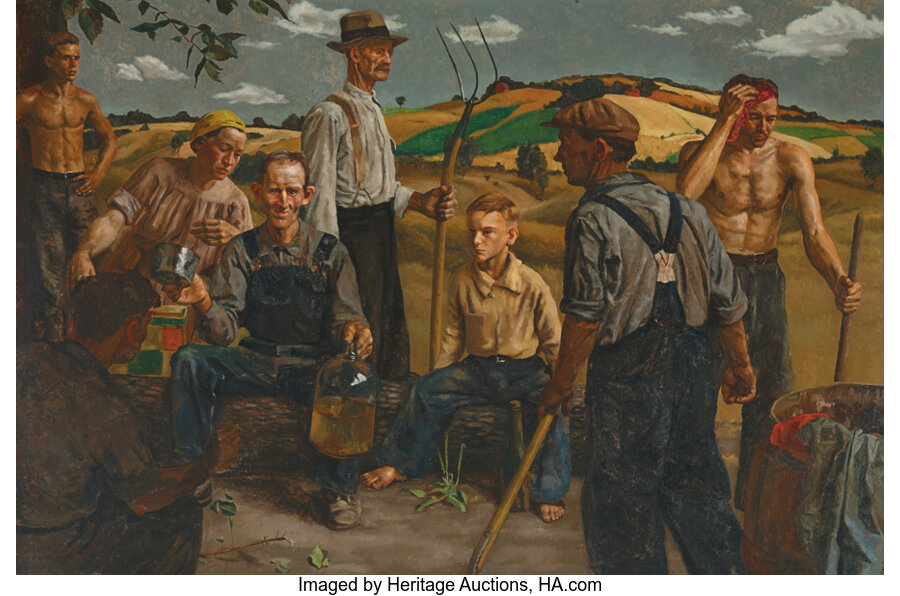The Slater Memorial Museum, Norwich Connecticut, "William A. McCloy in Retrospect: Themes and Issues," October 20-November 24, 1991.
The artist; Private collection, Concord, Massachusetts, by descent from the above.
William Ashby McCloy (American, 1913 -2001) Agricultural Lassitude, 1936 Oil on Masonite 48 x 72 inches (121.9 x 182.9 cm) PROVENANCE: The artist; Private collection, Concord, Massachusetts, by descent from the above. EXHIBITED: The Slater Memorial Museum, Norwich Connecticut, "William A. McCloy in Retrospect: Themes and Issues," October 20-November 24, 1991. LITERATURE: The Slater Memorial Museum, Norwich Connecticut, William A. McCloy in Retrospect: Themes and Issues, exhibition catalog, 1991, n.p., no. 54. William A. McCloy, a disciple of John Steuart Curry's Regionalist vision, subtly wove mysticism into the realism of his canvases. His works, often overshadowed by more prominent figures of the movement, deserve recognition for their authentic portrayal of Midwestern ethos. In Agricultural Lassitude, McCloy not only communicates the exhaustion implicit in the title but also reflects a broader commentary on the era's social and economic conditions. The year 1936 was still within the grips of the Great Depression, and the weariness of the figures serves as a metaphor for the plight of the American worker. Each figure's posture and expression are rendered with empathy, highlighting McCloy's skill in conveying complex human sentiment. Following a global upbringing in Nanking and Shanghai, McCloy settled back in the United States in 1926. He began his art education at the State University of Iowa, earning a B.A. in Art in 1930 (while also ranking as an all-American diver), followed by an M.A. in the Psychology of Art in 1936 after a brief stint at the Yale School of Fine Arts. McCloy's diverse training included painting, printmaking, and sculpture under esteemed educators such as Eugene Savage, Mauricio Lasansky, Humbert Albrizio, and Eugene Ludens. While at the University of Iowa, McCloy won first prize for painting at the Iowa State Fair but was unable to tour his prized work due to financial limitations. McCloy's academic career commenced at Drake University in 1937, but his defining tenure was at the University of Wisconsin, where, from 1939 to 1948, he significantly contributed as a mural assistant to John Steuart Curry on three murals and independently completed two major mural commissions. The two men grew to be so close that McCloy served as Executor of Curry's estate upon his death. This mentorship under Curry was instrumental in honing McCloy's artistic skills and deepening his understanding of the Regionalist narrative. The collaboration significantly influenced McCloy's approach to art, as seen in the two major mural commissions he later executed himself. McCloy's experiences with Curry not only fortified his technique but also helped to cultivate his thematic exploration of the American experience, mirroring the grandeur and humanity that Curry famously depicted. Agricultural Lassitude's composition, with its juxtaposition of the human figures (all locals from Iowa City) against the vastness of the landscape, emphasizes the symbiotic yet strenuous relationship between humans and the land. McCloy's technique—marked by textured brushwork and a nuanced palette—further underscores the gritty reality of farm labor. McCloy's exhibitions span prestigious venues such as The Chicago Art Institute and the Whitney Museum of American Art in New York, and his murals and sculptures grace institutions including Truax Field and Connecticut College. His works are esteemed parts of collections at The Library of Congress and the Slater Memorial Museum, among others. Agricultural Lassitude is a significant and evocative piece within the Regionalist canon and an enduring testament to McCloy's artistry, contributing a visceral chapter to the narrative of American Regionalism. Reflecting on his dynamic career, a quote by his mentor, John Steuart Curry, captures the essence of McCloy's approach: "Art is not what you see, but what you make others see." (J.S. Curry, "On Art and Artists") HID12401132022 © 2024 Heritage Auctions | All Rights Reserved
Under UV exam, there appear to be a few scattered spots of inpaint, most notable in the pants of the standing man with pitchfork; in the background, right of the yellow headscarf; and in the man's (wearing newsboy hat at right) face and collar. Screw and nail heads visible along the extreme edges. Faint 10 inch horizontal scuff to varnish layer in upper left quadrant.
Framed Dimensions 49 X 73 Inches


